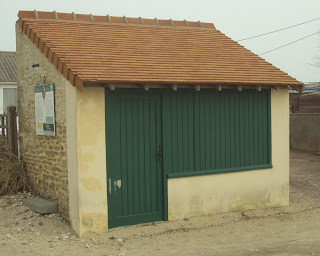The 50th Northumbrian Division landed on Gold Beach. The assault was conducted by 2 brigades, 69 Brigade on King sector and 231 Brigade on Jig sector. Once the beaches were secured, the follow on Brigades would land, 56 Brigade on Jig and 151 (Durham Light Infantry) Brigade on King.
Within the divisional artillery, fire support for the
assaulting phase was conducted by 86th and 9th Field
Regiments with SP guns on the Run in Shoot. The towed guns of 74 and 124 Northumbrian Field Regiments would not land till later. The Northumbrian Regiments did provide BC’s and FOO’s to the assaulting brigades.
At 05:00 6th June, the transport ships dropped anchor 12 km off the coast and started to lower their landing craft. At 05:30, soldiers started to board thir craft, and the preliminary bombardment of the German defences commenced. The bombardment would last till 06:30, and was augmented by heavy bombers of the USAF. On the approach of H-Hour as the troops neared the beach, the rocket firing Landing craft tank (rocket), supported by the divisional artillery self-propelled guns on the run in shoot engaged their allotted targets.
The bombardment was partially successful, some coastal batteries were neutralised and the shock shattered the morale of many of the defending troops. However, some key points remained intact, which would cause difficulties for the assaulting troops on the beaches and the subsequent establishment of routes off the beach. In addition, some of the specialist vehicles of the 79th Armoured Division sank in the heavy seas, which would reduce the capability to clear lanes on the beaches.
The difficulties were further compounded by 147 Field
Regiment being unable to fire on HAMEL on the run in shoot, though it was able
to augment the fires of 90th Field Regiment.
As a result of the heavy seas it was decided to land the DD
tanks nearer the beaches in shallow water. This worked well in KING sector, the
tanks being able to support the 69th Brigade; in JIG sector, the
deployment was delayed consequently the troops of 231 Brigade were without
armoured support till 07:58.
The assault on the JIG sector did not go to plan. The
failure to suppress the strong points around HEMEL, the loss of the specialist
vehicles to clear lanes on the beaches, and the delay in the arrival of
armoured support le to heavy casualties and the situation became chaotic. A
decision was taken to abandon the attack on strongpoint WN37, to concentrate on
WN36. This proved successful, and with gallant actions by the men of the 1st
Hampshire’s and 1st Dorset’s WN36 was captured and the movement
inland began.
 |
| 147 (Essex Yeomanry) Field Regiment RA Palques Anselles |
 |
| 147 (Essex Yeomanry) Field Regiment RA Palques Anselles |
As follow on troops arrived, together with the Self
Propelled guns of 147 Field Regiment, the bridgehead began to be developed.
This then allowed the follow on 56th Brigade to land at midday, 2
hours behind schedule, and the breakout continued.
On KING Beach, the assaulting companies of the 6th
Green Howards and 5th East York landed at H hour. Landing alongside
them were 38 DD tanks and breaching teams of the 79th Armoured
Division with AVRE’s Sherman Crabs and bulldozers. The preliminary bombardment had suppressed
defences in the area, and with their armoured support available, the 69th
Brigade attack was a rapid success. One notable act of gallantry was the
awarding of the Victoria Cross to to CSM Hollis.
 |
| CSM Hollis VC Hut. Plaque detailing CSM's Hollis actions |
 |
| CSM Hollis VC Hut |
The move off the beaches was temporally stalled by heavy
resistance in LA RIVERE. Effective naval
fire support coupled with an assault by 4th/7th
Dragoons knocked out a troublesome strong point and the advance continued.
The Northumberland Hussars had converted to Gunners at the
beginning of the war and had fought with the 50th Division in the
Middle East and Scilly.Equipped with the M10 SP tank destroyer, the anti-tank
batteries landed with the assault brigades from H + 90 onwards. RHQ and echelon came ashore with the follow
on brigades.
By late morning 69th Brigade has secured their
objectives and controlled the MEUVAINES RIDGE. This would set the conditions
for the breakout by the 151st (Durham Light Infantry) Brigade which
commenced landing at 10:30 |
| Gold Beach June 1944 |
 |
| 69th Brigade Entrance near Ver sur Mont Fleury |
The exits off the beach were secured and what would become known as 50th Divisional Way provided one of the vital routes inland for the division.
The 74th (Northumbrian) Field Regimen landed 7th to 9th June. The 124th(Northumbrian) Field Regiments would not be complere till 30th June. The guns of 74 and 124 Regiment would go on to support the 50th Division throughout the campaign in North West Europe.














.JPG)
















